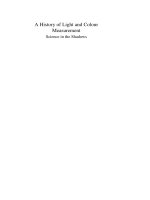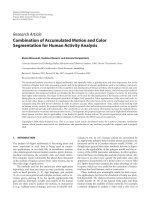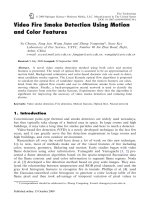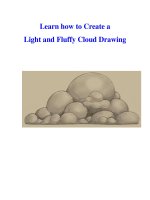Light and color workbook
Bạn đang xem bản rút gọn của tài liệu. Xem và tải ngay bản đầy đủ của tài liệu tại đây (4.56 MB, 23 trang )
light color
and
Table of Contents
Light and Color
Light
Light Sources
The Direction of Light
Reflection
Reflective Surfaces
Light Bounces
How Do We See?
Light Through Objects
Refraction
Bending Light Experiment
The Prism
Color Spectrum
Spinning Color Wheel
Light and Color
Mixing Colors
Complementary Colors
Light and Shadow
Drawing Light
Certificate of Completion
Want more workbooks? Join Education.com Plus to save time and money.
/>Copyright © 2012 Education.com. All Rights Reserved
Light
Light is one of the most mysterious parts
of nature. It allows your eyes to see objects
and colors, but if you close your eyes you
can still feel warmth and even sense color!
Light is the fastest traveling force that we
know of in nature. Even though it has no
weight, light can also act like an object it can be slowed down and it can be
moved (bent).
at
he
Sunlight is essential for all life on the
planet. It gives energy and heat. Plants
require sunlight to breathe and make
energy. Without sunlight, plants would
not be able to produce the oxygen
that animals need to breathe.
>>
>
e
ibl
vis
gy
er
en
>
>
>
ht
lig
>
ph
oto
sy
>
>
h
nt
is
es
the ground is
warmed by the sun’s rays
, pro
ducing sugar and oxyg
en
the house is warmed by
the sun’s rays
red light
Light Sources
Anything that produces its own light is called a light source. Some
are natural and some are manmade. Can you classify the following
light sources as natural or manmade?
candle, fire, star, sun, flashlight, lamp, lightning, TV,
light bulb, glow sticks, red hot iron, burning coals
Natural
Manmade
Did You Know?
Bioluminescence - is a biochemical
process where an animal creates
light but no heat. This light is used
for communication, camouflage, or
attracting a mate or prey. This is
a picture of a bioluminescent fish!
Copyright 2012-2013 Education.com www.education.com/worksheets
created by:
The Direction of Light
Light travels through the air in straight lines.
TRY THIS!
Get three index cards. Punch a hole near the top, going through
all three cards at once to make sure the holes line up later. Tape the
cards to blocks or other small objects to make them stand upright.
Set the three cards up in a row and shine a flashlight through them.
What do you notice?
Now, move one of the cards slightly out of line. What happens?
Copyright 2012-2013 Education.com www.education.com/worksheets
created by:
Reflection
Some objects do not produce their own light but do reflect it. Light
does not come from within these objects. Light shines on the object
and reflects, or bounces off of it. A mirror is an example of a reflective surface. It does not make its own light, but instead reflects it.
When light from an object is reflected by a surface, it changes
direction. It bounces off the surface at the same angle as it hits it.
Use a ruler to draw the angle of reflection below:
?
?
Try This!
Smooth surfaces tend to reflect light well, while rough surfaces tend
to scatter the light in many directions.
You can test this with a sheet of tin foil. Shine a light on it while it is
flat and note what you see. Then crumble it. What is the difference?
Think About It!
Would you be able to see a mirror in a completely dark room? Why
or why not? Use the back of this page to explain your answer.
Copyright 2012-2013 Education.com www.education.com/worksheets
created by:
Reflective Surfaces
Color in and list ive relective surfaces in this scene, illuminated by the car’s
headlights, that are helping to keep the driver and the bicyclist safe.
1.
2.
3.
4.
5.
Copyright 2012-2013 Education.com www.education.com/worksheets
created by:
Light Bounces
We can only see objects because they are either producing light or
light is bouncing off of them. If light did not bounce we would not be
able to see anything around us. A mirror is the best way to test this
because a mirror reflects nearly all the light that hits it without
distorting it.
TRY THIS!
Take a powerful flashlight and set it down somewhere. Turn it on and
don’t move it for the entire experiment. Now, pick several places or
targets in your room. Turn the lights down low and using a mirror in
your hand, adjusting it to different angles, try to hit the targets with
the light beam bouncing off of the mirror.
Did You Know?
The moon does not make
its own light. It reflects
light from the sun.
Copyright 2012-2013 Education.com www.education.com/worksheets
created by:
How Do We See?
Light travels in straight lines. When light hits an object, it is reflected and
enters our eyes. This is how we see the object.
ht
Lig
Light
Source
ed
lect
Ref
t Object
Ligh
The Eye
Check it out
Optic Nerve
Cornea
Lens
Pupil
Iris
Retina
Copyright 2012-2013 Education.com www.education.com/worksheets
created by:
How Do We See?
The iris is the colored part of our eyes. It expands and shrinks to adjust how
much light is let into the eye. The pupil is the black hole in our eyes. It what
the Iris controls to let in light. The cornea is a thin, clear film that protects our
eyes from the environment. The lens converts the light coming into our eyes
and projects it onto the retina. The retina has thousands of light-sensitive
nerves that send a message through our optic nerve and into our brain,
which is where we see.
Fill in the diagram of the eye.
TRY THIS!
Color blindness is a very common
condition. In extreme and rare cases
it means that the person cannot see
any color, only shades of gray!
In more common cases, a person
cannot tell the differences between
certain colors. The most common
example of this is red/green color
blindness, where a person has
difficulty seeing the differences
between these two colors. This
diagram is a test. Can you see the
number?
Copyright 2012-2013 Education.com www.education.com/worksheets
created by:
Light Through Objects
When light shines on an object, one of three things can happen:
1. If light passes through, the object is transparent.
2. If light is blurred, the object is translucent.
3. If light is blocked, the object is opaque.
Transparent
Translucent
Opaque
TRY THIS!
Try shining a flashlight through plastic wrap, wax paper and tin foil.
Fill in the sentences below to show what you observed.
Wax paper is ____________________________________________.
Plastic wrap is ____________________________________________.
Tin foil is _________________________________________________.
Copyright 2012-2013 Education.com www.education.com/worksheets
created by:
Light Through Objects
Transparent objects allow light to pass through completely, translucent
objects blur light, and opaque objects do not allow any light to pass
through them.
Can you tell which of the following objects are:
transparent, translucent, or opaque?
lemonade
dish soap
window
sunglasses
cardboard
clear plastic cup
construction paper
tissue paper
brick wall
Copyright 2012-2013 Education.com www.education.com/worksheets
created by:
Refraction
A light ray travels in a straight line, but it can bend when it changes speed.
When a light ray enters a denser medium such as water, it slows down.
This results in a “bent” or distorted image.
TRY THIS!
Put a pencil or straw in a cup of water.
Kneel down to the level of the cup and
look at the pencil or straw through the
water. You will notice that the pencil
looks like it is bent!
What’s Happening?
The pencil appears bent due to a property of light called refraction.
The distortion happens because the light ray slows down and changes
direction as it passes into the water, which is denser than air.
Try positioning the pencil or straw at different angles.
What do you notice? Is there a point at which the distortion is lessened?
Note your observations on the back of this page.
Copyright 2012-2013 Education.com www.education.com/worksheets
created by:
Bending Light Experiment
If your science savy third grader is up for a challenge, introduce her to
refraction. Refraction is a fancy science word for bending light, but you
won't need any fancy supplies for this activity. Using just a couple of
household items, your scientist will be bending light like a pro!
What You Need:
Opaque casserole dish
Small stone
Pitcher of water
Glass cup
Spoon
What You Do:
1. Have your child place the stone at the bottom of the casserole dish.
2. Ask her to take a comfortable seat at the table – she will have to hold her position for several
minutes. Have her pull the casserole dish towards herself so that she can see the stone. Now
have her push the dish away, stopping when the stone is just out of sight.
3. Explain to her that she cannot see the stone because there is not a straight line between her eyes
and the stone. Instead, you are going to make the stone reappear by bending the light.
4. Slowly pour water into the dish. Be careful not to shift the stone. Ask her to tell you when she can
see part of the stone.
5. Because light is refracted as it travels from the air to the water, she should be able to see the
stone. Water has a different density than air. The light beams bend and the stone is visible as if
she was looking around a corner.
6. Expand on this by showing her another example of refraction. Take a plain glass and place a
spoon handle inside of it. Pour water into the glass and the handle of the spoon will seem to
change positions.
7. Encourage your child to try out other bending light experiments. Anything with water will do the trick!
© Copyright 2006-2012 Education.com All Rights Reserved.
The Prism
While light appears white, it is made up of the colors of the rainbow. The
colors can be separated by shining light through a prism, or a triangular
glass object. This separation is called dispersion. This can be observed in
a rainbow, when sunlight is refracted by droplets of water.
Use crayons or colored pencils to fill in the color spectrum below.
R__
O_____
Y_ _ _ _ _
Wh
ite
Lig
ht
G____
B___
Prism
I_____
V_ _ _ _ _
TRY THIS!
Make your own prism by shining light down through a glass of water onto
white papers below, or shine a light on the back of a CD.
Be patient and experiment until you get the angle just right. Draw what you
observe below.
Copyright 2012-2013 Education.com www.education.com/worksheets
created by:
The Color Spectrum
The things we see come in an amazing variety of colors because of visible
light. We see different wavelengths of light waves as different colors. All of
the colors together make up white light.
TRY THIS!
To test this, cut out these 4-inch
circles and glue them onto cardstock. Color the wedges with the
ROYGBIV colors (red, orange,
yellow, green, blue, indigo,
violet). Spin the wheel on the end
of a pencil and note what happens. What color do you see?
Experiment with different color
combinations and see what you
can make.
Copyright 2012-2013 Education.com www.education.com/worksheets
created by:
Spinning Color Wheel
Want to help your curious third grader become a color magician? Help him
construct a dazzling spinning wheel that will teach him about the science
behind colors while providing some silly entertainment!
What You Need:
White paper
Cardboard
Glue
Scissors
Pencil
Hole punch
Markers
Yarn
What You Do:
1. Check out the Color Spectrum worksheet as a template for this activity. It has some awesome
facts about colors that your child might not be familiar with. Did he know that all the colors
together make up white light? If this fact seems too difficult for him to grasp, don't worry! That's
what this activity is meant to illustrate!
2. Have your child glue the white paper onto the cardboard. Cut out a circle from the cardboard. Make
sure the circle is at least six inches in diameter.
3. Tell your aspiring scientist to divide the circle into six wedges. Color the wedges in this order: red,
blue, green, yellow, orange, purple.
4. Use the hole punch to make two holes in the center of the circle. Thread a three foot piece of yarn
through the holes and then tie the yarn into a loop.
5. Wind things up. Twirl the yarn like you would turn a jump rope. Once the yarn is tightly twisted, pull
your hands apart, then bring them back together. Continue bringing your hands in and out as if you
are playing an accordion. If your cardboard is too light, the winder will flop not spin. To fix this
issue, take apart the winder and layer the cardboard.
6. As the wheel begins to spin faster, watch as the colors begin to blur together. Ask your child what
color he sees. Depending on the quality of the marker shades you used, you should see a light
grey. The goal, of course, is to see white, but that might take some more experimenting.
Encourage your child to try out some more color combinations on his color wheel. If he tries alternating
two primary colors like blue and yellow, what color does he predict will show?
© Copyright 2006-2012 Education.com All Rights Reserved.
Light & Color
When white light strikes an object, some of the colors are absorbed and some
are reflected. The reflected colors are the ones we see. For example, grass
appears green because all other colors are absorbed while green is reflected.
Green light is reflected by the grass, but what about the other colors we see?
A black shirt reflects very little light. A white shirt reflects a lot of light. Which
one do you think will feel warmer to wear in the sun? Explain your answer on
the back of this page.
Copyright 2012-2013 Education.com www.education.com/worksheets
created by:
Mixing Colors
Blue
Red
Yellow
Blue
Red, yellow and blue are called the
primary colors. From these three colors
all colors can be made by mixing them.
Purple
Orange
Green
TRY THIS!
Coloring Challenge: Using some paints (acrylic works best, but tempera
washable paint works too) try mixing the three primary colors in different
ways to create some special colors that match the drawings that are not in
the ROYGBIV spectrum. If you’re having trouble, try adding some white or
black into the mix.
Pear
Grapes
Pine Log
Storm Cloud
Copyright 2012-2013 Education.com www.education.com/worksheets
created by:
Complementary Colors
The colors that are opposite each other on the wheel are called
complementary colors. For example, blue and orange are opposite each
other on the wheel. They are complementary. If complementary colors are
mixed, they will make different browns and grays.
Purple & Yellow
Green & Red
Orange & Blue
Paint the roofs, doors and trim of the houses with the right
complementary color.
Copyright 2012-2013 Education.com www.education.com/worksheets
created by:
Light & Shadow
Shadows occur when an object
blocks a light source from reaching a certain area. Shadows are
darker, but there is always some
light that reaches them. We can
still see the color of something that
is shadowed, even if that color is
very dark.
The location of a shadow depends on where the light
TRY THIS! source is coming from. Color the ground next to this
boy with the shadow he casts. The sun is behind him.
If a light source is lower, the shadow will be longer. Draw an object in the
space below. Then color the ground and the shadow that it will cast.
On a separate piece of paper, paint a scene that has a light source and
an object that casts a shadow.
Copyright 2012-2013 Education.com www.education.com/worksheets
created by:
Drawing Light
We see all forms and objects in color. The way we can
can tell their shape and surface is by the
different tones and shadows. These
come from light bouncing off each
type of surface at different angles
and reflecting different colors.
TRY THIS!
Paint the box using the light
source to know which sides will
be darkest or lightest.
Draw and paint your own object using the light source
to color it.
Copyright 2012-2013 Education.com www.education.com/worksheets
created by:
Great job!
is an Education.com science superstar









